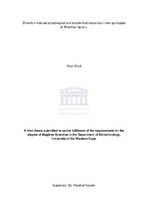| dc.description.abstract | South Africa is one of two countries responsible for the production of approximately
80% of the world’s Zr. The increase in mining activity has detrimental effects on the
environment, especially crop plants, as more pollutants are leached into the soil.
Consequently, it is necessary to understand how plants respond to this form of abiotic stress. Therefore, this study focused on determining the physiological and biochemical responses of two genotypes of Brassica napus L (Agamax and Garnet) in response to Zr stress. The levels of cell death, lipid peroxidation and ROS were higher in Garnet, whereas the chlorophyll content was higher in Agamax. Furthermore, native PAGE analysis detected seven SOD isoforms and seven APX isoforms in Agamax, compared to 6 SOD isoforms and 7 APX isoforms in Garnet. The results thus indicate that Agamax is tolerant to Zr-induced stress, whereas Garnet is sensitive. An assay for the rapid quantification of Zr within plant samples was subsequently developed, which revealed that Agamax retained the bulk of the Zr within its roots, whereas Garnet translocated most of the Zr to its leaves. The ability of Agamax to sequester Zr in its roots comes forth as one of the mechanisms which confers greater tolerance to Zr-induced stress. As a
consequence, our study sought to use the optical, physical and chemical properties of quantum dots to image the uptake and translocation of Zr in B. napus genotypes. ICPOES was also performed to quantify Zr levels in various plant organs. Data from the ICPOES revealed varying patterns of uptake and translocations between Garnet and Agamax. These patterns were similarly shown in IVIS Lumina images, tracing the transport of QD/Zr conjugates. This method ultimately proved to be successful in tracing the uptake of Zr, and could essentially be a useful tool for targeting and imaging a number of other molecules. | en_US |

